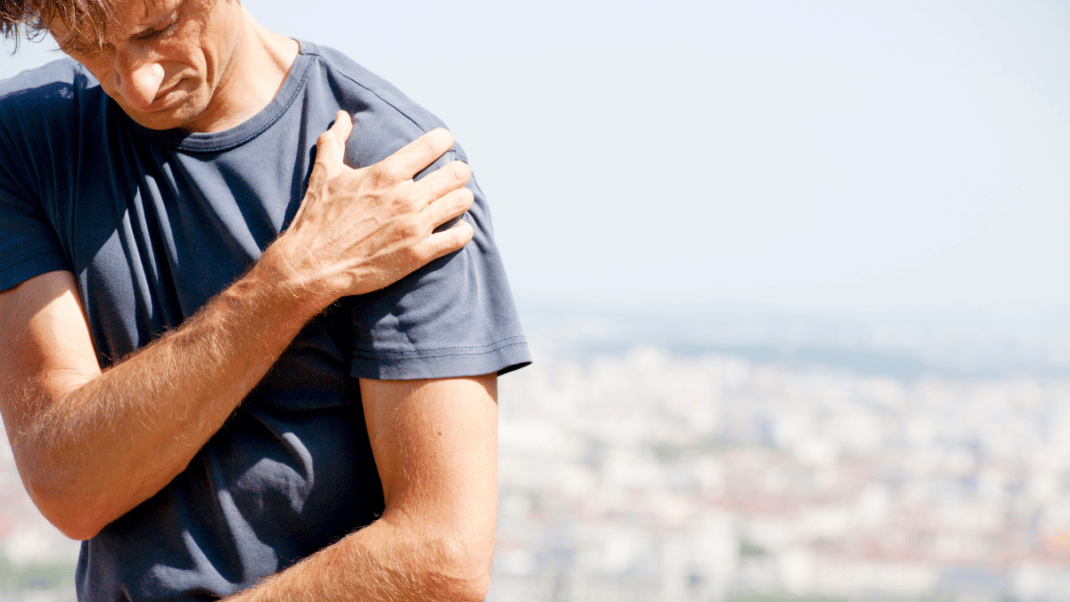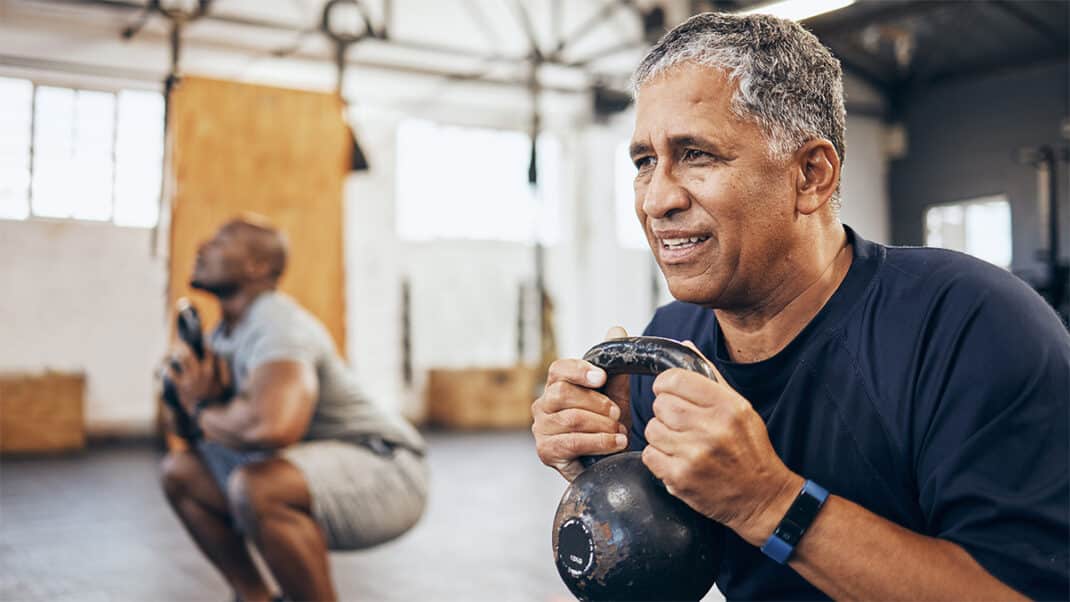Corrective Exercise for Shoulder Impairments
Identify root causes of dysfunction and help clients return to function and good form.
| Earn 1 CEC - Take Quiz

We use our shoulders a tremendous amount every day. Simple tasks like pouring milk for a bowl of cereal, doing a downward-facing dog or holding ourselves upright in indoor cycling class all require us to use our shoulders. Functional movements like walking, pressing and pulling are influenced by the shoulder joint, and a tender rotator cuff or inflamed bursa sac can make those activities—and even sleeping—almost unbearable.
Shoulder pain is prevalent in approximately 21% of the population, and dysfunction is common. Forty percent of reported pain lasts at least a year (Clark & Lucett 2012). Injuries can shelve clients for a month or more and, if not rehabilitated properly, can lead to chronic instability. This article discusses what’s happening in the shoulder complex and offers suggestions on how to assemble a sound corrective exercise program.
Tissues and Movement
Before focusing on the shoulder itself, let’s take a broad look at the human movement system. Keep in mind that this is an overview; trainers need a more in-depth review before programming corrective exercise routines for clients with shoulder impairments.
Connective tissue has viscoelastic properties, is either dense or loose and is designed to respond to everyday stresses. Under normal circumstances, it reacts to load or stress in various ways, depending on the rate at which force is applied, the magnitude of the load and its duration (Magee et al. 2007).
Each type of tissue has its own jobs and unique capabilities. Dense connective tissue—found in bones, ligaments, tendons and aponeuroses—is stiffer and can lengthen only 10% before tearing. Because it is relatively inflexible, dense tissue protects end ranges of motion, but injuries to this tissue are common. Loose connective tissue is a lot more forgiving. Found in joint capsules, muscles, nerves and elsewhere, it can lengthen up to 80% or more of its resting length without experiencing tension buildup (Magee et al. 2007). This is critical for the fitness professional to understand because, once you get to the point where the load has shifted primarily to the more densely wound connective tissue, any errors in technique or inability to handle load will be magnified.
A tissue becomes injured when it can no longer tolerate the load and deformation caused by a force’s velocity, angle, duration or frequency. Prior to experiencing a very common repetitive-stress shoulder injury like bursitis or tendonitis, movement impairments are routinely present. An effective personal trainer will be able to identify such impairments before they translate to an injury. Then it is possible to harness therapeutic exercises and help correct faulty movement patterns (Sahrmann 2001).
Shoulder Anatomy and the Passive System
The shoulder is much more than a single joint. The entire kinetic chain is connected “from toes to nose,” and listing all the interconnections is impossible here. However, as we look at the shoulder, we’ll include some of its broader connections to the rest of the body.
The human movement system incorporates the articular, nervous and muscular systems (Clark & Lucett 2010). For our purposes, we’ll refer to the articular system—which includes bones, joints and ligaments—as the “passive system,” and we’ll call the muscular system the “active system.”
The passive system provides anchor points, support and leverage for the muscular system. Traditionally, the major bones of the shoulder girdle are the humerus, scapula and clavicle. The shoulder complex extends to the rib cage and the thoracic and cervical spines. You can make a case to include the lumbar spine and pelvis as well, because of muscular and fascial connections. When the passive system is out of alignment, it can produce contraction in the active system, leading to lower work capacity, reduced endurance and greater risk of injury (Travell & Simons 1983).
The joints most closely associated with the shoulder include the glenohumeral (GH) joint, the acromioclavicular (AC) joint, the sternoclavicular (SC) joint and the scapulothoracic (ST) joint. While an in-depth exploration of these joints is beyond the scope of this article, personal trainers must educate themselves thoroughly on these joints before designing programs for clients.
The ST joint is considered a false joint because it lacks a true bony articulation. The scapula (shoulder blade) simply floats on the thorax; however, due to its importance in the shoulder’s functionality, it must be included. The intervertebral and costovertebral joints associated with the thoracic spine can influence both local and global musculature (Epstein et al. 1993). Although small, these joints are integral details of the thorax.
When bones are in ideal alignment, full range of motion becomes possible in the joints. For example, the GH joint should be able to fully flex, extend, abduct, adduct, internally rotate, externally rotate and circumduct. This joint is highly mobile and can move through large ranges of motion. To allow for that mobility, there must be a low degree of stability. The ST musculature helps decelerate movements like throwing, since it anchors the shoulder blade to the thorax and the humerus to the scapula via the glenoid.
The scapula sets the platform for the humerus. If the scapula is out of alignment, the humerus will follow (Sahrmann 2001). The scapula should be able to elevate, depress, protract, retract, upwardly rotate and downwardly rotate. It is said to “tilt” anteriorly and posteriorly as well. The acromion process of the scapula attaches to the clavicle at the AC joint.
The acromion is a thick, ridge-like bone that can have three different shapes. These shapes—classified as flat (type 1), smoothly curved (type 2) and hooked (type 3)—determine how much space the rotator cuff, biceps brachii tendons and bursa sacs have to operate in. Abnormalities in the acromion are congenital, and all the corrective exercise in the world will not create more space. A type 3, or hooked, acromion is associated with a greater incidence of rotator cuff tears (62%) and impingement (30%) (Epstein et al. 1993).
It can be difficult to assess alignment and functionality of the SC and ST joints. Maintaining their subtle actions will foster shoulder health and function. If you suspect that either joint is dysfunctional, refer out to a licensed medical professional for examination (Lee 2003).
Thoracic spinal alignment and function are often overlooked. In people who are very sedentary, the thoracic spine is often stuck in flexion and has limited extension and rotation. An overly kyphotic posture decreases the effectiveness of the scapular stabilizers and rotator cuff musculature (Clark & Lucett 2010). Scapular malalignment is reason enough to assess and address thoracic mobility.
The shoulder’s ligamentous structure is of particular interest. Ligaments aren’t just flat, straight guy wires that provide static support to joints. They can twist and turn like an intricately wound rope. At end ranges of motion, ligamentous tension increases—as does support from the joint capsule—in an attempt to prevent injury. Ligaments also serve a proprioceptive function, providing the nervous system with valuable feedback about joint position and tension (Osar 2012).
Cartilage provides smooth surfaces for joints to interact with. Faulty arthrokinematics and osteokinematics (movement of the joints and bones) will wear this tissue down over time. When cartilage breaks down, pain and inflammation soon follow.
The subacromial, ST and subdeltoid bursa sacs reduce friction in the shoulder joint. The subacromial bursa is most frequently inflamed after repeated impingement between the humerus and acromion.
Repetitive stress breaks down the active system more quickly than it does the passive system. If a client is experiencing pain as a result of an insult to the passive system, a movement impairment has likely been present for a period of time. The active system is more easily disturbed. It doesn’t take long for tendonitis to occur when someone exhibits poor posture and form, loaded repeatedly.
The Shoulder and the Active System
Muscles can be grouped into local stabilizers and global movers (Clark & Lucett 2010). That is not to say that a muscle only stabilizes or only creates global movements, but many muscles have characteristics that lend themselves to one category versus the other. Local stabilizers are composed mostly of type I muscle fibers, are single-joint muscles and are prone to inhibition. Global movers contain a higher percentage of type II muscle fibers, cross more than one joint and are prone to tightness (Clark & Lucett 2010).
In 1987, Vladimir Janda introduced a categorization system for muscles based on their phylogenetic development (evolutionary history) (Janda 2013). Tonic muscles are associated with flexion and are developmentally “older.” Phasic muscles are “extensors” and develop shortly after birth. Think of a baby snuggled up in a ball, pulling his bottle to his mouth. The feet and knees come in with the bottle. A flexor synergy is already built in, but the baby can’t yet achieve hip, knee and ankle extension; the central nervous system needs time to develop. So what does this have to do with the shoulder? When we experience pain or stress or are chronically sedentary, we tend to default to the flexion pattern, which over time can set up muscle imbalances.
The ST and thoracohumeral muscles are among those potentially affected by these imbalances. Even in their size, the tonic muscles have an unfair advantage (Sahrmann 2001). The pectoralis major and latissimus dorsi dwarf the trapezius, serratus anterior and rhomboids. As the rhomboids—along with the latissimus dorsi and levator scapulae—downwardly rotate the scapula, they often betray their phasic counterparts (Sahrmann 2001). The serratus anterior and lower and upper trapezius upwardly rotate the scapula and can’t overcome the poor posture and domination created by the downward rotators (Muscolino 2008; Sahrmann 2001). A flexed thoracic spine also contributes to scapular dyskinesis (poor movement).
Fascial lines also need to be taken into consideration. Among other things, fascia is responsible for support, proprioception and force transmission (Myers 2001; Schleip 2003). Fascia and related connective tissue form “tracks” throughout the body, and these can be mapped and assessed (Myers 2001). Locally, the arm lines run from various aspects of the shoulder area down to the attachment points around the hand. These fascial lines can temper range of motion at the shoulder girdle. For more information about fascial lines, read “Whole-Body Strength Training Using Myofascial Lines,” by Derrick Price, MS, in the April 2012 issue of IDEA Fitness Journal.
Assessments
Assessments provide you with the requisite information to individualize a program. Proper implementation is a separate article in itself; invest in the proper education so that you thoroughly understand assessment protocols. Correlate results from a series of assessments (cluster testing) to provide you with an accurate representation of the alignment, structure and function of the shoulder complex. The following assessments are recommended (Clark & Lucett 2010):
- static postural assessments
- transitional assessments
- dynamic movement assessments
When performing static postural assessments, observe all five major load-bearing joints from the anterior, lateral and posterior views. Look at the feet, knees, pelvis, shoulders and head—the five kinetic-chain checkpoints. Simple transitional assessments like Appley’s Scratch Test or a shoulder rotation test can help pinpoint asymmetries in range of motion, as well as provide some insight into thoracic mobility (Clark & Lucett 2010; Cook et al. 2010).
Other transitional assessments—such as the overhead squat, push-up or pressing test and the pull-up or pulling test—demonstrate how the shoulder complex integrates with the rest of the kinetic chain (Clark & Lucett 2012). When you are conducting an overhead squat assessment, have the client start in neutral alignment, and observe 5–10 repetitions from the anterior, lateral and posterior views. Also look for asymmetries and movement compensations elsewhere in the kinetic chain.
Every assessment is an exercise, and every exercise is an assessment. Observe your client during pressing and pulling movements like the standing cable chest press or split-stance tubing row. Change your view every few repetitions, and monitor all five checkpoints. Watch for shoulder elevation, thoracic flexion, cervical extension or arching in the low back. If a client is executing the movement with good form and has the requisite stability and mobility, progress the exercise. For more detailed information about shoulder assessments, see the sidebar “Assessment and Corrective Exercise Clinic.”
Corrective Exercise Programming
Once you’ve identified postural faults or movement compensations, you’re ready to create a corrective exercise program to restore alignment and function. Corrective exercise programs may last 10–60 minutes, depending on the severity of the movement impairment and the client’s current capacity for exercise. These programs follow a specific methodology or school of thought. While there are multiple systems and approaches, these points apply somewhat universally:
- Research by Bang and Deyle suggests that supervised corrective exercise programs are more advantageous than unsupervised workouts (Bang & Deyle 2000). Make sure clients use optimal form as often as possible. Stacking strength on top of dysfunction is a recipe for disaster (Cook et al. 2010).
- Self-massage techniques help clients “normalize” soft tissue. Dysfunctional tissue may lack extensibility, be neurally overactive or have developed trigger points. Trigger points are hyperirritable points within muscle tissue that, when stimulated, can produce local or referred autonomic nervous system sensations such as pain, tightness, inhibitions or even goose bumps (Travell & Simons 1983). It is important to restore proper tone and tissue extensibility before implementing any other corrective strategy. A muscle that has been very overused or is wrought with adhesions won’t allow a joint to move freely or an antagonist to activate properly. Self myofascial release, trigger point therapy, active release and many other techniques can help clients with this stage.
- Joint mobilization exercises, which include gentle, repetitive and even oscillatory movements, encourage joints to move through all three planes of motion. Poor joint movement can lead to local and systemic dysfunction. It is not within a personal trainer’s scope of practice to manually facilitate joint mobility by placing hands on a client. This is reserved for licensed manual therapists. Save stretching for muscles that are chronically shortened. There is a time and place for static, active, muscle energy and dynamic techniques. Fitness level and stage of training will guide you in selecting the most appropriate technique for each client.
- Lengthened or weak muscles can lead to negative postural changes and joint instability (Sahrmann 2001). Developing proper neuromuscular activation in inhibited muscles is necessary. Activation techniques include manual therapy (refer out), isolated isometrics, eccentric and concentric muscular actions and targeted movement patterns. The client’s joint mobility, core stability and coordination will help you select the most pertinent technique for restoring neural activation.
- Addressing proper breathing mechanics is also important. Dysfunctional breathing patterns can exacerbate upper crossed syndrome (Clark & Lucett 2010). Taking the time to educate clients on how to breathe well from different positions will not only enhance functional capacity but also help restore healthy length–tension relationships and quality of movement to the shoulder complex. Teaching diaphragmatic breathing during the activation portion of the workout may be particularly rewarding and can help decrease sympathetic tone in tonic muscles (Osar 2012).
- Neuromuscular reeducation exercises help clients ingrain new movement patterns into their central nervous systems. Disuse and overuse can lead to poor movement quality. Corrective exercise seeks to reteach fundamental movement patterns used in work, sport and life. Exercises performed in the standing position using multiple joints can help develop functional strength and coordination. While it can be difficult to gauge the correct number of sets and exercises for a corrective exercise program, the strengthening protocols typically follow a low- to moderate-volume approach of 2–3 sets with 8–15 repetitions. However, your assessment and the individual’s specific needs will determine the program. Build a repertoire that will challenge and fatigue the client, but make sure he or she can complete it with good form.
Critical Link in the Chain
A critical region of the kinetic chain, the shoulder complex is often misused and abused. Providing effective corrective exercise programs to minimize shoulder impairments can help you stand out from the competition and lead to referral streams from your existing client base and medical professionals. A good trainer can help a client come back from an injury; a great trainer will spot dysfunction before it turns into an injury and know how to program correctly for it.
Movement Errors and Contraindications
Accurate data are needed to determine which corrective strategies a client needs. A trained, experienced corrective exercise specialist will also be able to pinpoint movement errors. Repetition and coaching will sharpen assessment skills.
Common shoulder complex dysfunctions include the following:
Unwanted shrugging. This is fairly easy to spot. Underactive lower trapezius muscles let the upper trapezius and levator scapulae run away with the show and pull the shoulder blade up. This alters glenohumeral (GH) and cervical spine alignment, which can lead to headaches, a tight neck and inflamed bursa sacs.
Shoulder blades that don’t protract and retract. Think of the client on the seated row machine who is moving only from the GH and elbow joints. The loss of scapular action increases range of motion at the elbow and shoulder joints and, over time, may lead to tendonitis. This also closes off space in the anterior aspect of the shoulder, which may put more strain on the biceps tendons, bursa sacs and rotator cuff tendons.
Note the following training tips and programming guidelines:
Be careful about using the cue “Put your shoulder blades in your back pockets.” While it may be useful during a prone cobra pose, that doesn’t mean the shoulder must always stay back and down. Elevation and upward rotation are critical actions during overhead activities.
Avoid barbell upright rows, full-range-of-motion dips or anything that makes the joints go past safe end ranges when shoulder impairment is suspected. Behind-the-neck barbell presses can also be dangerous. As the bar is lowered past the crown of the head, two things typically happen: The head goes forward, placing the cervical spine in extension and causing greater uneven force distribution through the cervical disks; and as the bar continues to go down, the load transfers from the active system to the passive system. In the close-packed position of abduction, external rotation and extension at the GH joint, there is nowhere else to create movement without also creating laxity in the ligaments and joint capsule. If an asymmetry is present, the risk for injury is even higher. The combination of a bilateral grip, barbells and asymmetries is not a healthy mix.
Be aware that lateral and anterior raises increase impingement risk and add stress to the cervico-thoracic region (Osar 2012). Fixed-range-of-motion machines can be dangerous in this scenario, but you can work around them for a safe and effective workout. Lower the seat toward the bottom of most fixed-machine shoulder presses to limit exposure to excessive end ranges of motion. Bottom line: Know the range of motion for joints and don’t go past their physiological end range.
Important Takeaways
- Think globally; act locally. Look at the entire kinetic chain and then burrow down to the smaller details around the shoulder complex.
- Pain is a messenger; don’t kill it. When the rotator cuff screams during every pull-up, don’t just “choke it out” with a foam roller or tennis ball. Try to find out why it’s yelling. If you suspect more than a muscular imbalance or overuse, refer out to a qualified professional.
- Free the thoracic spine before the scapulae. The scapulae float on the posterior thorax and are intimately interconnected with the thoracic spine. The scapulae will not move properly until the foundation of the thorax and thoracic spine are functioning optimally.
- Include some “up” exercises. More scapulae are stuck in downward rotation than not. Restore upward rotation before operating directly overhead.
- Let shoulders do their job. Don’t let clients’ shoulders do the work of the hips and abdominals. Poor core and hip mobility make the shoulders work harder during total-body movements.
- Remember: Practice makes a pattern. Make sure your clients are practicing the right patterns, not the same old ones that got them into trouble.
- Don’t rush things. It generally takes time for shoulders to lose function; it will also take time to return your clients’ shoulders to their aesthetic and functional glory.
Assessment and Corrective Exercise Clinic
To deepen your understanding of how to properly and safely perform shoulder assessments and design corrective exercise programs, review the following products from the IDEA Store (www.ideafit.com/fitness-products):
- The Fundamentals of Structural Assessment, by Justin Price, MA (DVD)
- Shouldering the Load From the Ground Up, by Chuck Wolf, MS (CEC course and DVD)
- Designing a Self Myofascial Release Program, by Justin Price, MA (CEC course)
- Corrective Exercise for Shoulder Impairments, by Eric Beard, MS (CEC course)
- Six Steps to Better Program Design, by Michol Dalcourt (CEC course and DVD)
References
Bang, M., & Deyle, G. 2000. Comparison of supervised exercise with and without manual physical therapy for patients with shoulder impingement syndrome. Journal of Orthopedic and Sports Physical Therapy, 30 (3), 126-37.
Clark, M., & Lucett, S. 2010. NASM Essentials of Corrective Exercise Training. Philadelphia: Lippincott Williams & Wilkins.
Clark, M,. & Lucett, S. 2012. NASM Essentials of Personal Fitness Training. Philadelphia: Lippincott Williams & Wilkins.
Cook, G., et al. 2010. Movement: Functional Movement Systems: Screening, Assessment, Corrective Strategies. Santa Cruz, CA: On Target.
Epstein, R., et al. 1993. Hooked acromion: Prevalence on MR images of painful shoulders. Radiology, 187 (2), 479-81.
Janda (The Janda Approach Seminars). 2013. www.jandaapproach.com/the-janda-ap
proach/philosophy/; retrieved July 2013.
Lee, D. 2003. The Thorax: An Integrated Approach. Minneapolis: OPTP.
Magee, D., et al. 2007. Scientific Foundations and Principles of Practice in Musculoskeletal Rehabilitation. St. Louis: Saunders.
Muscolino, J. 2008. The Muscle and Bone Palpation Manual with Trigger Points, Referral Patterns and Stretching. St. Louis: Mosby.
Myers, T. 2001. Anatomy Trains: Myofascial Meridians for Manual and Movement Therapists. Toronto: Churchill and Livingstone.
Osar, E. 2012. Corrective Exercise Solutions to Common Hip and Shoulder Dysfunction. Chichester, England: Lotus.
Sahrmann, S. 2001. Diagnosis and Treatment of Movement Impairment Syndromes. St. Louis: Mosby.
Schleip, R. 2003. Fascial plasticity—a new neurobiological explanation: Part 1. Journal of Bodywork and Movement Therapies, 7 (1), 11-19.
Travell, J., & Simons, D. 1983. Myofascial Pain and Dysfunction: The Trigger Point Manual, Volume 1: The Upper Extremities. Baltimore: Williams & Wilkins.
Eric Beard, MS
I am passionate about helping people move better, feel better and live better. I successfully integrate manual therapy and corrective exercise into all of my clients, patients and athletes programs to keep them healthy and performing at their best. I have presented to over 10,000 fitness professionals over the last ten years and deeply enjoying the experience of simultaneously learning and giving back. I have a love for public speaking and have also enjoyed coaching other trainers, corrective exercise specialists and massage therapists since 2009. Education + Inspiration + Consistent Commitment = Powerful Results!





